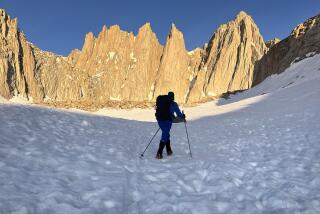THE NATION - News from May 3, 2009
- Share via
CONCORD, N.H. — While stranded on New Hampshire’s Mt. Washington, Eagle Scout Scott Mason plunged into frigid water, built a rock shelter to protect himself from the mountain’s notorious winds and watched a rescue helicopter fly away as he tried to attract the crew’s attention.
Even with a sprained ankle and “frost-nipped” toes, the cool-headed 17-year-old said that things could have been a lot worse after he sank several times into mountain runoff hidden beneath waist-deep snow.
“The runoff was about 2 1/2 feet deep and probably running 30 mph,” he told the Associated Press last week. “The guides confirmed I could have gotten sucked in if I had fallen all the way in, and I would have been gone.”
Mason, of Halifax, Mass., headed up the popular mountain for a long day hike on April 25, but decided to take a shortcut down after spraining his ankle. That’s when he ran into rising water and deep snow until searchers spotted him Tuesday morning as he headed toward the mountaintop weather observatory.
“I was going to hike to the observatory and kind of knock on their door and try to get some hot cocoa and a ride down,” he said in a telephone interview.
Mason got his ride down the 6,288-foot mountain Tuesday morning, into the waiting arms of his parents, sister and aunt.
During his struggle on the mountain, Mason’s planned emergency route led him into unexpected trouble.
“I had a light sprain coming up, so I decided to take an easier hike down,” he said. He chose a route he had discussed with the staff at the Appalachian Mountain Club lodge where he began his hike. “They had information that it was clear at the time.”
But he soon discovered that unseasonably warm weather had wrought dramatic changes.
“When I got down there, the rivers were much more rapid than they should have been,” he said. He decided to cross earlier than at his planned crossing point, which put him in an area without trails.
Wearing plastic bags inside his boots to keep his feet dry, he began trying to find a way out. Mason said that even though he was stranded, he wasn’t lost; he’d hiked the area before and knew the landmarks. Ironically, Mason said, the original 17-mile loop was clear and dry.
Last Saturday and Sunday nights, Mason crawled beneath snow-covered pine trees and hunkered down on the snow in a bivouac or bivvy sack, a waterproof sleeping bag shell.
He started fires with a hand-sanitizer gel.
“You can put it right on what you are burning, and even on the snow you can make a fire,” he said. “I was able to make a fire just because I ripped down some big evergreen branches.”
By Sunday afternoon, his snow-covered route down still blocked by raging runoff, Mason decided he had to go back up the mountain.
Monday, above the tree line, he tried signaling a helicopter, waving his hiking poles and reflective bivvy sack. But the crew was focused below his level, more concerned that Mason might have tried to take a trail across a river and been swept away.
“It was a little disappointing,” he said.
Monday night, Mason found a large crevasse in a rock that was partially protected from the wind, built a higher windscreen with rocks and slept until well after daylight Tuesday, when he resumed his slow trek toward the summit.
“I wasn’t in a rush,” he said. “I just didn’t want to trip or anything.”
That’s when he and a search team spotted each other.
Mason thanked rescuers who endured the same treacherous conditions to look for him. “Anyone can go through the ice into an underground stream,” he said. “They were risking their lives to try to save me.”
In his Scout troop, Mason teaches younger boys survival and wilderness skills. He said he will review making fires, even in the snow. And he’ll tell them about hiking alone.
“I would never hike alone again in snow conditions,” he said.
More to Read
Sign up for The Wild
We’ll help you find the best places to hike, bike and run, as well as the perfect silent spots for meditation and yoga.
You may occasionally receive promotional content from the Los Angeles Times.






